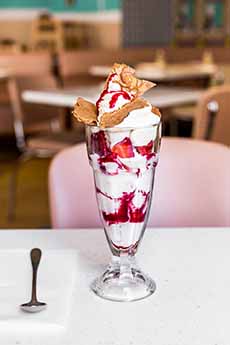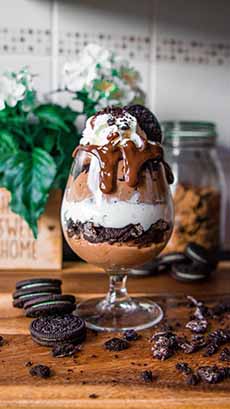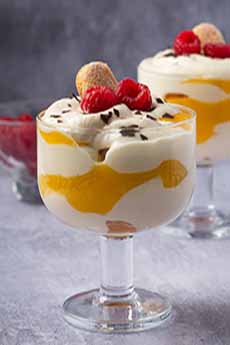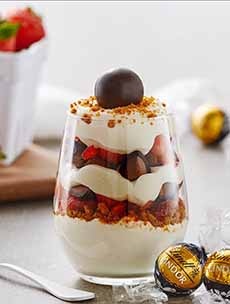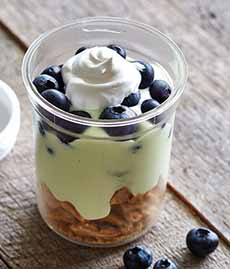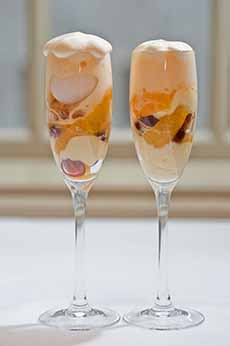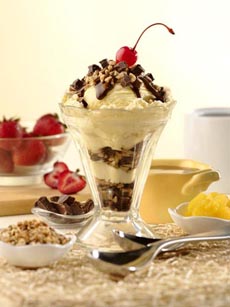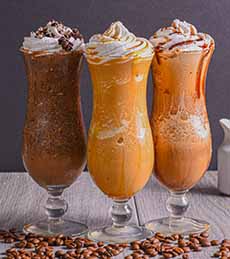Parfait History & A Key Lime Yogurt Parfait For National Parfait Day
|
|
November 25th is National Parfait Day, which celebrates a delicious ice cream treat a bit more sophisticated than the sundae. (The ice cream sundae was also invented in the U.S. National Chocolate Parfait Day is May 1st.) The history of the parfait is below. We also have a recipe for a Key lime yogurt parfait below, which exchanges the ice cream for Greek yogurt. The difference between butterscotch and caramel—both sauces that can be layered in parfaits, and often used interchangeably—but they’re quite different. But first: The Parfait Create all the flavors of a Key lime pie in a yogurt parfait! Thanks to Pampered Chef for the recipe. If you’re avoiding sugar, you can make your own Key lime yogurt and use a powdered sugar substitute (Recipe #2). Enjoy this for breakfast or dessert. 1. PLACE the graham crackers on the bottom of a stemmed glass or other glass container. (Note: You can use any kind of glass to make a layered parfait, as you can see in the photos. But if you don’t have any appropriate glasses or glass dishes, just use any dish. It won’t have the parfait eye appeal, but it will taste just as good.) 2. LAYER with the yogurt, blueberries, and whipped topping. If you can’t find ready-made key lime yogurt, it’s easy to make your own. 1. ZEST the lime, then juice it. 2. COMBINE all ingredients in a large bowl and whisk to blend. 3. TASTE the yogurt and adjust the sweetener, as desired. The term “parfait“ is of French origin and translates to “perfect.” The history of the parfait is a bit complex, as the term has been used to describe various dishes throughout different times and places. However, when people refer to an ice cream parfait, they are generally talking about a layered dessert made with ice cream, toppings, and sometimes other ingredients like fruits and nuts—as you can see in these photos. Here’s a brief overview of the history of the term “parfait” and how it became associated with the layered ice cream dessert: In France, the term “parfait” traditionally refers to a frozen dessert made from a base of sugar syrup, egg, and cream. This French parfait is similar to ice cream but is made by churning the ingredients as they freeze, and does not include layers of syrups, sauces, fruits, etc. In the U.S., it would be called a “frozen soufflé.” In the context of a frozen dessert made with cream, eggs, sugar, and flavorings, the term “parfait” likely gained popularity in late 19th or early 20th century France. That frozen dessert became part of French cuisine and eventually found its way into international culinary traditions. The American Parfait In the U.S., the term “parfait” took on a different meaning. American parfaits evolved into layered desserts typically served in tall glasses. These parfaits often involve a combination of ice cream, whipped cream, fruits, nuts, and syrups—layered, not mixed. We can’t pinpoint who invented the ice cream parfait and when. There is no documented origin story. But we give thanks to the chef or home cook who first thought to layer conventional toppings with ice cream in a tall glass. In the mid-20th century, parfaits gained popularity in the U.S., becoming a popular dessert choice in restaurants and homes. The layered presentation made them visually appealing, and the combination of different textures and flavors contributed to the delightful experience. The beauty of the parfait concept lies not only in its appearance but in its versatility. As yogurt became popular in the 1970s, yogurt parfaits debuted, layered with fruit and topped with granola. It is now used in overnight oats recipes and more. Over time, the term “parfait” expanded to savory foods, used to describe layered dishes in different cuisines. There are layered parfaits from caviar with crème fraîche to mashed potatoes with grated cheddar (there are recipes for both below. There are also savory yogurt parfaits, layering plain Greek yogurt with diced cucumbers, tomatoes, legumes, feta, chopped vegetables (roasted veggies, beets), grains (quinoa), herbs, nuts, etc. Today, the ice cream parfait is a popular dessert enjoyed around the world, and it continues to be a favorite treat due to its combination of flavors and textures, from classic to creative, such as a maple-pecan parfait with maple ice cream, maple-caramelized pecans, maple ice cream, a drizzle of maple syrup, a topping of crunchy maple granola, and maple-infused whipped cream, etc. Butterscotch sauce and caramel sauce are sometimes referred to interchangeably, but they are not the same. While someone who likes one is likely to enjoy the other, they are made using different ingredients and techniques, resulting in distinct taste profiles. Here are the key differences between butterscotch sauce and caramel sauce: |
|
|
Ingredients CHECK OUT WHAT’S HAPPENING ON OUR HOME PAGE, THENIBBLE.COM.
|
||
